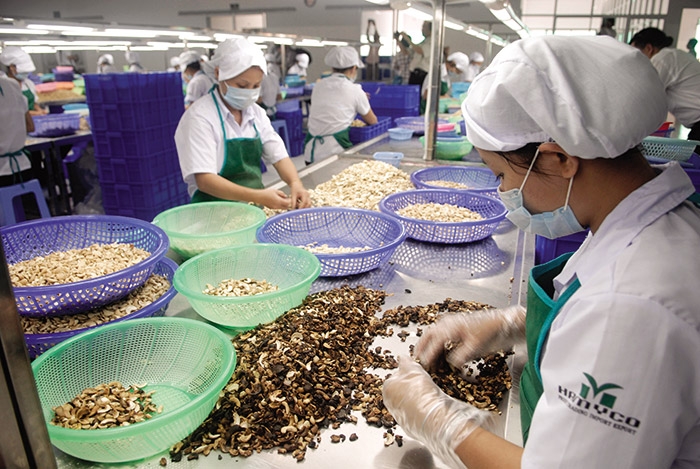Agriculture sector breaking records
 |
| Many contracts are being signed for 2019, signalling strong prospects for the sector, Photo: Le Toan |
Nguyen Duc Long, CEO of Long Nam Trade and Investment Company which specialises in farm produce exports in the northern province of Hung Yen, is negotiating with South Korean and Indonesian partners new contracts to export coffee in the first half of 2019.
“It is expected that next month we can finalise the contracts, which will follow our current successful contracts with these partners for this year,” Long told VIR. “Our company’s 11-month export turnover climbed by 20 per cent and the same rate is expected for the whole of 2018.”
Currently, half of the company’s total revenue and profit come from exports.
The success has contributed to the Vietnamese agro-forestry-fishery sector’s laudable export achievements in the 11 month period. The Ministry of Agriculture and Rural Development (MARD) last week reported that the agro-forestry-fishery sector enjoyed a trade surplus of $7.5 billion, lower than the $7.93 billion in last year’s corresponding period. It is also higher than the whole economy’s total trade surplus of $6.81 billion in the first 11 months of this year.
The sector’s total 11-month export turnover reached $36.3 billion, up 9.1 per cent compared to the same period last year, when the figure was $33.14 billion.
Nguyen Do Anh Tuan, director of the MARD’s Institute of Policy and Strategy for Agricultural and Rural Development, said the sector is “performing well despite natural calamities.” “The exports of many items have strongly increased both in price and quantity, such as rice, coffee, aquatic products, rubber, cashew, and wood. This has led to trade surplus in the sector,” Tuan said.
For example, Vietnam exported 5.7 million tonnes of rice, up 5.6 per cent on-year, with the value of $2.9 billion, up 17.7 per cent on-year.
The country also exported 1.73 million tonnes of coffee worth almost $3.3 billion, up 23.4 per cent in quantity and 3.2 per cent in value on-year.
Meanwhile, in the first 11 months of this year, Vietnam exported 301,000 tonnes of cashew nuts with export turnover of $3.1 billion, up 4.5 per cent on-year in quantity and down 4.2 per cent in value.
Phan Minh Thong, chairman and general director of locally-owned Phuc Sinh Corporation, which produces and exports agricultural products, told VIR that since early this year, the company’s total export turnover exceeded $200 million, and the figure is expected to be $260-280 million this year, far higher than last year’s $200 million.
Nguyen Ton Quyen, vice chairman of the Timber and Forest Product Association of Vietnam, told VIR that many furniture makers in Vietnam are seeing bright prospects. “Almost 100 per cent of exporters have landed big export contracts until the year’s end and even the first half of next year,” Quyen said. “The local wood industry is projected to hit a record export turnover of about $9.5 billion this year, up from last year’s record $7.6 billion.”
In the first 11 months, the industry enjoyed a record export turnover of $7.23 billion, up 15.7 per cent on-year.
Wood Land, one of Vietnam’s biggest wood exporters, has signed contracts for the whole year, with an expected turnover of $55 million this year, up from the $50 million last year. In another case, Nam Dinh Nafoco JSC has also landed export contracts for the entirety of 2018, with a forecast turnover of $50 million this year, up from $45 million last year. Many others – like Tien Dat, Dai Thanh, Cancia Pacific, Hiep Long, Minh Phat, and Phu Tai located in the central and southern regions of the country – have also inked contracts for the whole of 2018. They are also expecting an export turnover of $30-50 million, up 10-15 per cent year-on-year.
While enterprises’ production is increasing, the global demand for Vietnam’s wooden products has been rising strongly, focusing on key markets such as the US – which imports 43 per cent of Vietnam’s total wood exports, China (14 per cent), Japan (14 per cent), and South Korea (over 10 per cent). Periodically, exports will increase strongly in the year’s fourth quarter, while the demand from these key markets have risen by 20 per cent a year.
What the stars mean:
★ Poor ★ ★ Promising ★★★ Good ★★★★ Very good ★★★★★ Exceptional
 Tag:
Tag:
Related Contents
Latest News
More News
- Double-digit GDP growth within reach with shift to higher-value expansion (January 06, 2026 | 08:33)
- Takeda Vietnam awarded for ongoing support of Vietnam’s sustainability efforts (December 31, 2025 | 21:00)
- Vietnam's retail market tops $269 billion in 2025 amid e-commerce boom (December 31, 2025 | 19:00)
- Stronger legal framework urged as trade fraud surges online (December 31, 2025 | 18:58)
- FPT exports first chip shipment to Japan (December 31, 2025 | 10:47)
- AkzoNobel rolls out sustainability campaign “It All Adds Up” for the wood sector (December 31, 2025 | 09:23)
- Textile apparel firms deliver robust earnings despite global tariff pressures (December 30, 2025 | 10:09)
- Businesses ramp up production as year-end orders surge (December 30, 2025 | 10:05)
- Vietjet chairwoman awarded Labour Hero title (December 29, 2025 | 13:06)
- How to unlock ESG value through green innovation (December 29, 2025 | 10:03)





















 Mobile Version
Mobile Version